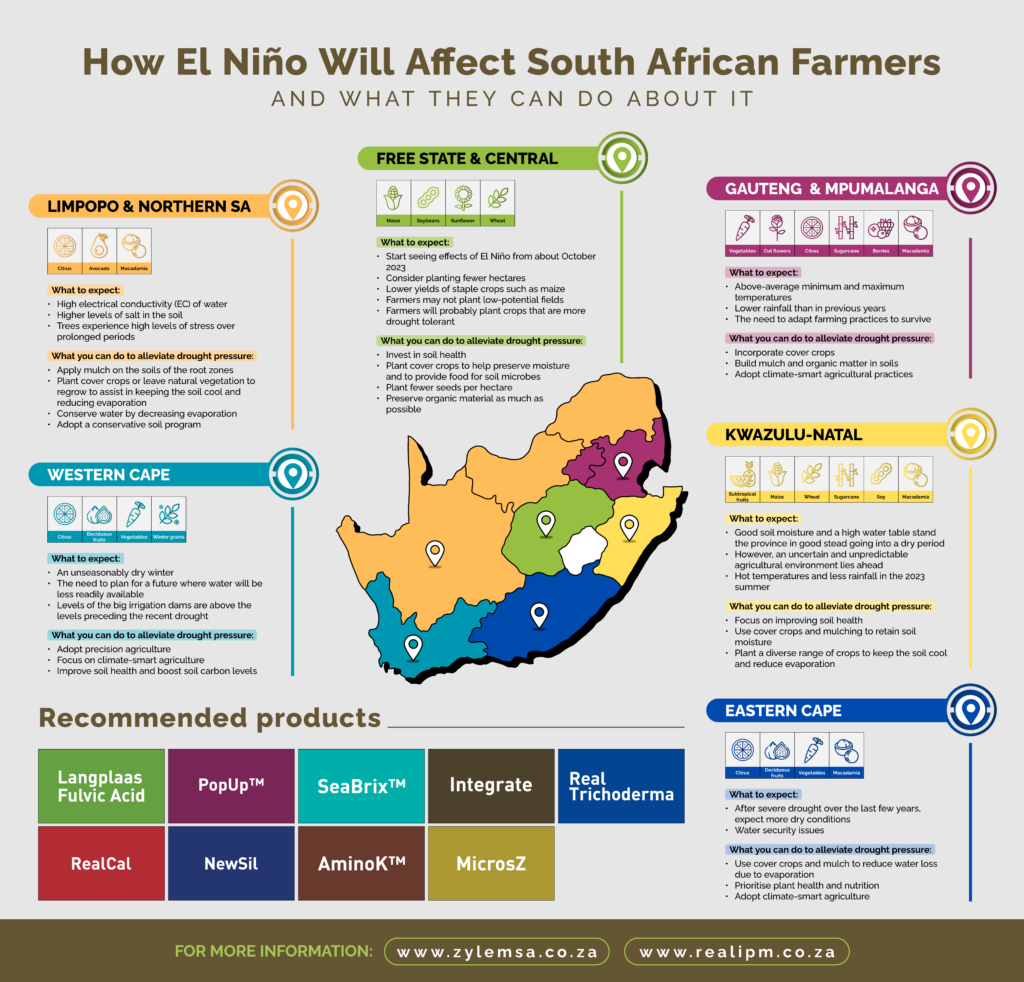As South Africa braces for the potential return of El Niño, farmers across the country need to be prepared to navigate the challenges that come with this climate phenomenon.
El Niño is associated with increased temperatures and low rainfall, which can significantly impact agricultural productivity. Previous El Niño droughts led to significant losses in crop and livestock production, highlighting the importance of proactive measures. While recent seasons benefited from La Niña-induced heavy rains, the return of El Niño could resemble the bleak agricultural conditions experienced in the 2015/16 season.
To help farmers adapt to the impending drought, RealIPM Area Managers (AMs) have provided valuable insights and recommendations for various regions and crops. By implementing these strategies, farmers can mitigate the potential effects of the El Niño drought and safeguard their agricultural operations.
The Impact of El Niño
El Niño is expected to significantly impact South African agriculture, potentially leading to drought conditions and reduced crop yields. A large share of South Africa’s agriculture relies on irrigation, with crops like maize, soybeans, sugarcane, and wheat heavily affected by drought conditions. Livestock farmers face challenges related to reduced grazing land, increased feed costs, and the spread of diseases in drier and warmer conditions. This could have significant implications for the country’s agriculture and food security.
“In the upcoming winter, we do not expect much of an effect yet. But In the upcoming summer (from about October 2023), we do expect that farmers will plan and do things differently from last year,” says Johnnie Matthew, Free State & Central Area Manager.
Farmers need to be proactive and plan accordingly to minimise the negative consequences. The specific effects of El Niño may vary across regions, but the general consensus among the AMs is that adjustments in farming practices will be necessary.
Recommended strategies from RealIPM Area Managers:
Soil management and conservation
Maintaining soil health is crucial during drought periods. RealIPM AMs emphasise the importance of soil conservation practices such as planting cover crops and preserving organic material. “Plant cover crops to help preserve moisture and to provide food for soil microbes,” says Matthew. Gauteng AM Evan Scholtz agrees: “People will be forced to accelerate their plans to incorporate cover cropping, build mulch and organic matter in their soils to ensure that they can compete with drought. If they don’t adapt they won’t survive.”
As summarised by Dewald Kamffer in the Limpopo region: “A conservative soil program is an affordable and effective tool to increase the ability of the tree to utilise minerals from the soil; increased efficacy of the roots of the trees lead to less fertilisation (saving money), and in return, less salts are added to the root zone and surrounds. Taking care of the soils using these tools will increase the longevity of the crop, increase the plants’ abilities to handle environmental stresses (that are unavoidable), and be more sustainable over the medium and long term in the uncertain and unpredictable environment of export agriculture in South Africa.”
Crop selection
Farmers should consider adjusting their crop selection to favour drought-tolerant varieties. “Farmers may not plant low-potential fields,” Matthew says, “they will probably plant crops that are more drought tolerant, for example, maybe plant more maize and sunflower and less soybeans.” By selecting crops that are better adapted to limited water availability, farmers can increase their chances of achieving favourable yields despite the impending drought.
Water management
Efficient water management is critical during drought conditions. In regions heavily reliant on irrigation, farmers should adopt measures to reduce water loss due to evaporation. Implementing mulching techniques and using biological inputs can help minimise water evaporation and improve water penetration. Furthermore, investing in technologies that optimise water usage, such as precision irrigation systems, can significantly conserve water resources.
Sustainable farming practices
RealIPM AMs stress the importance of sustainable farming practices as a long-term solution to combat the uncertainties of climate change. By adopting climate-smart agriculture techniques and focusing on improving soil health, farmers can enhance their crop resilience and adaptability to climatic extremes.
Diversification and adaptation
To mitigate the potential risks associated with drought, farmers should consider diversifying their crop portfolios. By growing a mix of crops with varying water requirements, farmers can distribute the risk and increase their chances of maintaining productivity even in adverse conditions. Additionally, farmers must be open to adapting their farming plans and strategies based on evolving conditions and forecasts.
Region-specific recommendations
This infographic highlights region-specific strategies for dealing with drought.

The best mitigation is preparation
As South Africa faces the potential return of El Niño and the subsequent drought period, farmers need to be proactive in their preparations. By implementing strategies such as soil conservation, crop selection, water management, sustainable farming practices, and diversification, farmers can mitigate the impact of the impending drought on their agricultural operations. Adapting to the changing climate patterns and adopting resilient farming techniques will contribute to the long-term sustainability and success of South African agriculture in the face of climate challenges.
Photo by Fiona Smallwood on Unsplash
Relevant Agribook pages include “Weather and climate“
